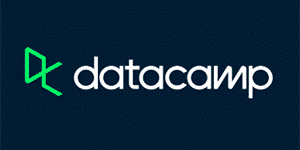The global market size for big data is expected to grow from $49 billion in 2019 to $103 billion by 2027. This type of immense growth ensures that data scientists and analysts will be some of the most sought-after experts in the years to come. There are many ways to learn data science, but today I will be evaluating one very specific platform for doing so: DataCamp.
DataCamp is the data science learning platform of choice for major corporations such as Ikea, Deloitte, Intel, PayPal, and Electronic Arts. Noticing that, I knew I had to give the platform a try. I wanted to see why it’s becoming a market leader in data science training at such an astonishing pace.

Are DataCamp courses enough to start a lucrative career in the booming big data industry? Let’s find that out in this review of DataCamp, where I will assess the popular data science online learning platform to see whether it lives up to the hype.
Table of Contents
What is DataCamp?
DataCamp is a data science online learning platform founded in 2014 by Belgian data scientists Jonathan Cornelissen, Martijn Theuwissen and Dieter De Mesmaeker. DataCamp offers online courses that use a web-based code editor for hands-on coding training. R, Python, and SQL courses make up the majority of DataCamp’s courses.
Who owns DataCamp?
DataCamp Inc. is a privately held company that is currently managed by CEO Martijn Theuwissen. Martijn is one of the three co-founders of the company since its inception in 2014, together with Jonathan Cornelissen and Dieter De Mesmaeker.
What is DataCamp Limited?
DataCamp Inc., the data science learning platform covered in this review, should not be confused with DataCamp Limited, as they are two entirely different companies. DataCamp Limited is a London-based internet technology company that offers dedicated servers, a content delivery network called CDN77, and network monitoring tools.
What is DataCamp XP?
DataCamp XP is a symbolic point-system that rewards DataCamp students for engaging in online lessons. XP is awarded to students for progressing in courses, exercises, and projects. DataCamp XP cannot be traded for paid DataCamp content.
Is DataCamp recognised?
While those familiar with DataCamp recognize it for what it’s worth, most data scientists are still unfamiliar with the platform. Also, as DataCamp is not a university-backed and fully accredited platform, it is not considered recognized in the traditional sense.
How does DataCamp work?
DataCamp works by offering hands-on coding courses to companies and individual students on its online learning platform. Learners on DataCamp practice skills in data-related topics, to build and maintain data fluency. DataCamp primarily teaches programming with the R, Python, and SQL programming languages.
Here’s how to use DataCamp as a beginner in six simple steps:
Fill out an introductory survey
When you start using DataCamp for the first time, you are given an introductory survey that is designed to determine your initial preferences. As you might know already, DataCamp mostly offers courses in three programming languages: Python, R, and SQL.
Choose a programming language
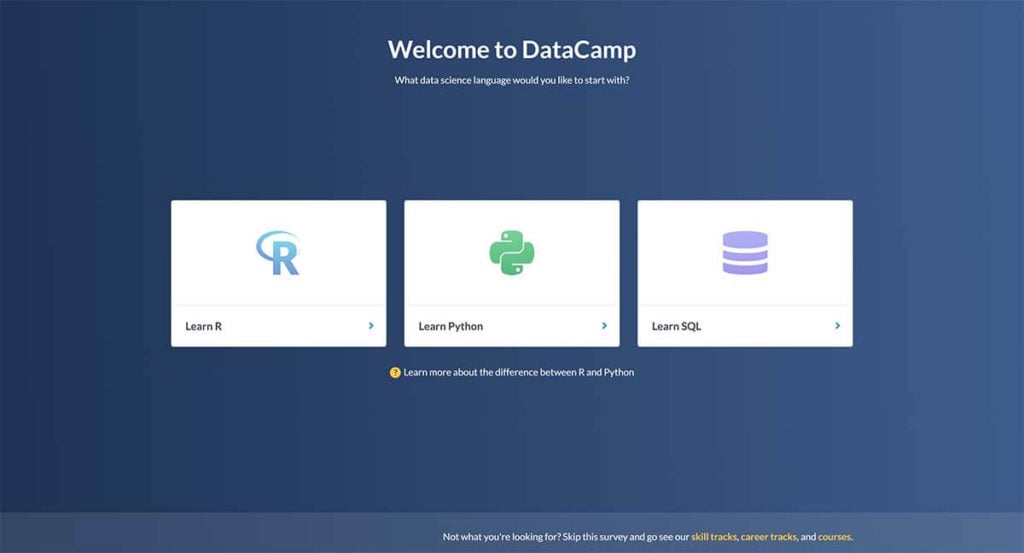
You should decide: do you want to learn data science with Python, R, or SQL?
R is a programming language specific to statistics and it has the best selection of MOOCs on DataCamp. Python is a more general-purpose programming language and at a close second in terms of available DataCamp courses.
For a first-time programmer, I would advise starting with Python. It’s slightly easier to learn, and it can be used for a wider range of purposes than R, giving it extra versatility.
R, on the other hand, is best suited for those of you who want to learn to code specifically for data science. For data science and analytics, it’s a highly efficient language. Unlike Python, it’s not considered a general-purpose programming language, though, so keep that in mind.
Take a skill assessment
If you’re a complete beginner, you can skip over this section and move to the next. For total beginners to programming, the “Introduction to Python”, “Introduction to R”, and “Introduction to SQL” free courses are a perfect place to start. Therefore, if you have no experience in programming, you can just skip the skill assessment and begin with those free courses.
However, if you have some previous experience in programming, it’s now a good time to take DataCamp’s skill assessment. This will determine your current skill level and suggest courses accordingly.
Start your first DataCamp course (or Track)
Now’s the time to start your first lessons on DataCamp. Here’s where you should decide whether you want to start with an individual course or a Track. such as the one in the picture below. Or, whether you want to go straight into a Skill Track or Career Track. If you took a skill assessment in the previous step, then take note of what is suggested to you.
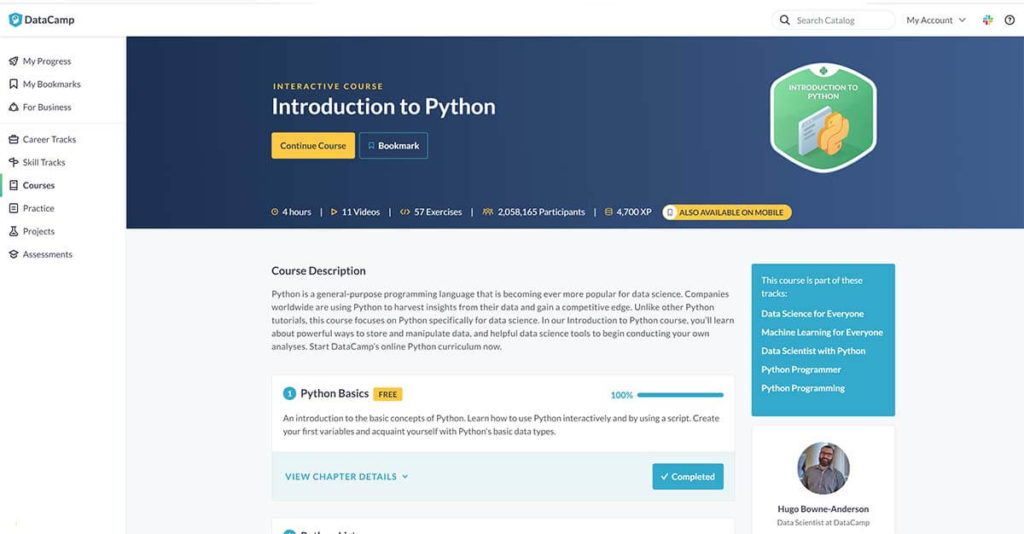
If you’re completely new to programming, then starting with one of these introductory courses is probably your best bet. The course starts with the very basics: types, variables, basic calculations. Therefore, even if you have never written or read a single line of code, you will be able to follow the material very easily. The introductory courses on SQL and R are similarly basic and aimed at beginners.
Pass the course syllabus
Passing the initial DataCamp lessons is a relatively easy task, even for a novice programmer. Here’s an example lesson from the “Introduction to Python” course that shows how DataCamp lessons work:
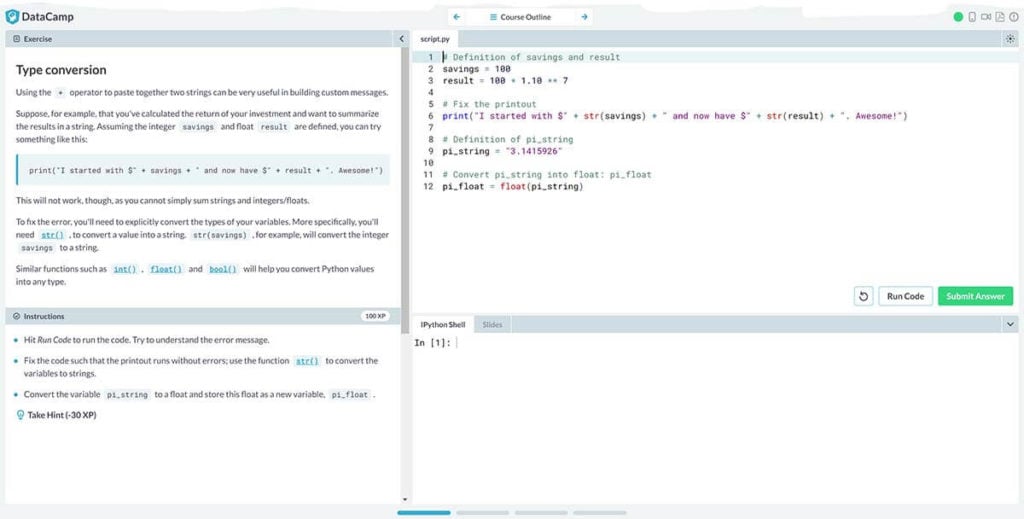
When you take a coding course on DataCamp, most of the learning will take place on interactive web-based code editors like this. I’m a big proponent of this interactive type of e-learning, as it allows students to become active participants in their own learning experience. The only aspect I was sometimes not happy with was that too large portions of the code often came pre-written.
My advice to you would be to take it slow. Like a sponge, soak in all the knowledge taught to you during the initial course lessons. You will undoubtedly need these bits of knowledge both in later lessons and in your future career.
Complete other courses, tracks, projects
When you finish your first online course on DataCamp, you should be proud of yourself. After all, you managed to accomplish a significant step towards becoming a data expert. The beginning is always the most difficult.
However, at the same time, don’t get caught up in the glory of the shiny certificate you just received. Becoming data fluent will require more time and dedication, so if that’s your end goal you should look into other, more advanced courses, tracks, and projects on the platform.
Now that you’re familiar with the basic of using DataCamp, let’s have a look at it’s pricing.
How much does DataCamp cost?
As of 2022, DataCamp offers four pricing plans:
- Basic. This package is free and gives you access only to the first chapters of each course, together with 6 free courses of your choice. While this package is quite limited, it’s a good chance to give the platform a try before committing to a purchase.
- Premium. This is the standard plan for individuals and costs $25 per month if billed annually, or $39 per month if billed monthly. This subscription plan gives you full access to all courses on DataCamp.
- Teams. This plan is meant for smaller teams that want to have multiple users within single account. It costs $25 per month.
- Enterprise. This plan is meant for larger organizations that want to implement data training. To get an exact price, you’ll have to request a quote from DataCamp.
Are there discounts on DataCamp?
Now and then, DataCamp has discounts across the board. However, if you want to get a discount straight away, then there is one option you can take advantage of. All students who pass the first lesson of any free course instantly get up to a 50% discount. Therefore, take a simple course, such as “Introduction to Python”, pass the first chapter, and you should get a discount instantly.
Is there a free trial on DataCamp?
DataCamp does not publicly offer a free trial. However, through a partnership GitHub, you can get DataCamp free trial memberships for 3 months. You can view GitHub’s offer here (restricted to students).
What is free on DataCamp?
DataCamp’s free plan gives students access to the first lesson chapter in all DataCamp courses. Also, students can freely access 7 projects, 1 skill assessment, and all coding challenges. Further course lessons and premium projects, however, require payment.
Why is DataCamp so expensive?
DataCamp is not particularly expensive if you ask me. However, the costs could be attributed to hiring industry expert instructors, developing DataCamp’s custom web-based code editor, and content creation. If you consider the cost of all these factors, then DataCamp isn’t that expensive.
Review of DataCamp Tracks
Tracks are DataCamp’s version of offering micro-credentials to students. These Tracks are more comprehensive than regular short courses, and they are designed to develop competence in specific skill sets and career paths. This means that a Track certificate serves as a form of proof that the student has effectively learned a branch of data science through online training.
DataCamp offers two types of Tracks:
Skill Tracks
Skill Tracks are DataCamp’s method of teaching students specific coding skills through hands-on interactive coding lessons and videos. If you’ve ever used Coursera, then you could compare DataCamp Skill Tracks to Coursera’s Specializations. Both of them develop deep competence on a particular topic, through a series of interconnected courses. DataCamp, however, is the superior choice when it comes to data science programming lessons. That is because it utilizes a web-based code editor, which I am a big proponent of.
As of the writing of this DataCamp review, there are a total of 43 Skill Tracks available. As usual, they are categorized into the three programming languages that DataCamp teaches: R, Python, and SQL. Due to the large number of options available, I will not list them individually in this review.
DataCamp’s Skill Tracks typically take between 13 and 28 hours to finish, and they consist of 4 to 7 individual courses. They are designed to enable learners with no prior knowledge to progress their knowledge one step at a time. If you take a Skill Track, you can expect to learn a specific skill set such as Data Visualization with Python. The magic of it is that you can quickly go from “Zero to hero” in a single data science topic (even if it is a narrow topic).
For example, the “R Programming” Skill Track starts with the basics of Python programming, by introducing topics such as vectors and data frames to beginners. Then, it builds on this kind of fundamental knowledge by introducing more complex topics such as loops, vectors, and parallel programming tools & techniques. Students start the Skill Track as total beginners, and graduate as immediately experienced R programmers.
Career Tracks
Career Tracks are the most intense data science online training programs available on DataCamp. They are comparable to micro-credential programs from other MOOC sites such as Coursera’s MasterTrack programs or edX’s MicroMaster’s programs. However, the duration and price of DataCamp’s Career Tracks are significantly lower than those two types of programs. After all, you can access all of the Career Tracks with a single monthly subscription.
As of the writing of this DataCamp review, there are a total of 14 Career Tracks available, with three programming languages to choose from: R, Python, and SQL. DataCamp’s Career Tracks consist of up to 30 individual courses and take between 45 to 115 hours to complete. They are designed to be the ultimate tool to help you land a job as a data wizard due to their complexity and comprehensiveness. However, are they all that they set out to be?
Well, DataCamp’s Career Tracks certainly are an excellent deal. The selection of different courses is excellent, and a monthly Premium subscription gives you unlimited access to absolutely all of them. And, to sweeten the deal even more, DataCamp has some of the very best instructors on its team. The DataCamp instructor roster is packed full of data scientists from companies such as Google, AT&T, and Cornell University.
Alternative platforms for studying data science such as Udacity and Springboard also offer fantastic content. However, when you start to compare their price points it becomes evident that DataCamp wins by a long shot. DataCamp Premium can be bought for around $30 a month and it gives you access to all of DataCamp’s Career and Skill Tracks. Springboard, on the other hand, asks for $7,500 for a single Data Science course.
In my opinion, DataCamp’s Career Tracks are one of the most cost-effective online training programs for learning data science with Python, R, or SQL. You really can’t go wrong with studying on DataCamp: worst-case scenario, you lose $30.
Review of DataCamp's Python courses
In this section of my review of DataCamp, I will evaluate it in the context of learning Python programming. Python is currently one of the world’s most popular programming languages, and that’s for good reason. Python is:
- Easy to learn
- Used for a wide range of purposes
- Second most popular language for data science
- Popular for developing machine learning, deep learning, A.I applications
If you’re a novice programmer, then Python is a very solid choice to start with. It’s general-purpose, meaning that you can code with Python for a wide range of uses, not just data science. And, DataCamp has a fantastic selection of Python courses, tracks, and projects available.
Is DataCamp good for learning Python?
Yes, DataCamp is an excellent platform for learning Python. Through a web-based code editor, students on DataCamp learn Python with hands-on programming exercises. It’s worth mentioning, though, that DataCamp mostly teaches Python in the context of data science and analytics, rather than general-purpose programming.
Python courses
As of the writing of this review, there are a total of 128 DataCamp Python courses available. These courses are ideal types of training programs for students who want to learn data science and analytics through Python. These courses all make use of DataCamp’s web-based code editor, which means that all the courses are hands-on and practical. Besides the few videos mixed in between here and there, all of the training takes place through the code editor.
Next up, I’ll show you some of my favorite examples of DataCamp Python courses:
- “Data Manipulation with pandas” is a 4-hour Python course that teaches pandas data frames. Anyone familiar with data science knows the widespread use and importance of pandas data frames. This course is a beginner-friendly and easy-to-understand introduction to pandas – a must-learn for any data expert.
- “Python Data Science Toolbox” is a 3-hour Python course that teaches highly useful skill sets for a Python data scientist. Python scoping, lambda functions, variable-length arguments, and custom functions are just some of the valuable skills taught during this short course.
DataCamp’s Python courses are led by industry experts, and there are courses available for all possible experience levels. For reference, here are some of DataCamp’s most active Python course instructors:
- Hugo Bowne-Anderson, one of the most recognizable members of the DataCamp team, offers 7 courses and 1 project in Python. His focus is on introductory courses aimed at beginners. Hugo is also the host and producer of DataCamp’s podcast, DataFramed.
- Team Anaconda, the folks behind the innovative data science application Anaconda, offer 6 Python courses on DataCamp. They focus on training data visualization, using pandas and data frames.
- Justin Bois, a professor at the California Institute of Technology, teaches 4 DataCamp Python courses. He is an expert at using Python for statistical thinking purposes.
Python projects
Together with online courses in Python, DataCamp students can choose from a total of 39 Python projects. These Python-based student projects are designed to help you build a portfolio of work that you can show to potential employers. Course certificates are nice, but provable hands-on experience is even better.
I will give you some examples of why DataCamp Python projects are both fun and valuable:
- “Exploring 67 years of LEGO” is a Python-based project led by Ramnath Vaidyanathan. During the project, students learn how to analyze a large database (the Rebrickable database) with the help of panda data frames. Showing this kind of a project to an employer will demonstrate numerous key abilities of a good data scientist.
- “Exploring the Bitcoin Cryptocurrency Market” is a Python-based project led by Juan González-Vallinas, another experienced data scientist. This project teaches students how to use panda data frames to manipulate and visualize big data related to cryptocurrencies. Students who take this course will also learn valuable information regarding the cryptocurrency market and its key players. This is a perfect project for anyone interest in data science and finance.
All DataCamp projects are designed and led by data science experts from across the globe. Take Rasmus Bååth, for example, who leads 5 DataCamp Python projects. He has led data science teams at King Entertainment (owned by Activision Blizzard) and Castle.io, an innovative cybersecurity company. Having the chance to develop projects with the help of accomplished data scientists like these is a fantastic opportunity.

Python tracks
As mentioned in the section on Tracks, these are interconnected series of courses that build strong competence in particular skill sets.
DataCamp offers the following 7 Python-based Career Tracks:
- Python Programmer: 52 hours, 13 courses
- Data Scientist with Python: 84 hours, 22 courses
- Data Analyst with Python: 60 hours, 16 courses
- Machine Learning Scientist with Python: 93 hours, 23 courses
- Data Engineer with Python: 71 hours, 18 courses
- Data Science for Everyone: 100 hours, 27 courses
- Machine Learning for Everyone:115 hours, 29 courses
DataCamp Skill Tracks are similar to but shorter than Career Tracks. They typically consist of 4 to 7 individual courses.
Review of DataCamp's R courses
Next up in this review, I will DataCamp’s R online training programs. Unlike Python, R is a highly specific coding language and not general-purpose. It’s built specifically for data manipulation, and it’s ideal for working with advanced statistical calculations. Because of this, R is one of the world’s most widely adopted programming languages for data science, and it’s the language of choice for many of the world’s top data scientists.
Here are some reasons to learn data science with R:
- Designed specifically for data science and analysis
- Widely used among top data scientists and researchers
- High volumes of community-packages
Normally I would advise newcomers to start with Python. However, if you’re certain that you want to go down the data science career path, then I would recommend you to go with R. Currently, you can’t get any better than R when it comes to developing data-driven applications.
Is DataCamp good for learning R?
Yes, DataCamp is fantastic for learning data science and analytics with R. The number of R courses on DataCamp exceeds any other programming language on the platform, and the courses are led by worldwide data experts. For these reasons, DataCamp is one of the best resources for learning R.
R courses
As of the writing of this review, there are a total of 152 DataCamp R courses available. Compared to the 128 available Python courses and 24 SQL courses, the choice for R courses is outstanding. Therefore, if you intend to study data science with R, you will have lots of resources to learn from on DataCamp.
As was the case with Python courses, all DataCamp R courses take place inside the web-based code editor. This means that above all else, you will get practical coding experience through the platform, rather than theoretical.
Here are some of the most noteworthy R courses on DataCamp that I have come across:
- “Introduction to R” is an introductory 4-hour R course developed by Jonathan Cornelissen, ex-CEO and co-founder of DataCamp. This course starts with the very basics of R programming, before digging deeper into fundamental topics such as vectors, matrices, factors, data frames, and lists. For a beginner, this course serves as a fantastic introduction to R.
- “Inference for Numerical Data in R” is a 4-hour R course led by Mine Cetinkaya-Rundel from Duke University. It’s designed to give an overview of statistical inference methods using R. If you already have a knowledge of statistics and are learning R programming, this course is an excellent point to start with, together with the more general “Introduction to R” course mentioned previously.
R projects
Similarly to the Python-based projects I covered earlier, DataCamp offers 40 R-based practical projects for its students. These projects don’t result in certificates, but they are some of the best-in-class training programs for learning practical data science.
To give you a clearer idea of the type of projects that are available on DataCamp, take a look at these examples:
- “Phyllotaxis: Draw Flowers Using Mathematics” is a freely accessible R project developed by Antonio Sánchez Chinchón. Through the use of ggplot2 packages, this course takes you through the steps necessary to create flower art with R. Kind of an unusual application for the R programming language, but a fun one nonetheless.
- “Exploring the Kaggle Data Science Survey” is an advanced R project created by Amber Thomas. This course uses a 2017 Kaggle Data Science Survey as a data source and teaches students how to analyze the data contained within to find the most popular tools and techniques used by Kaggle participants.
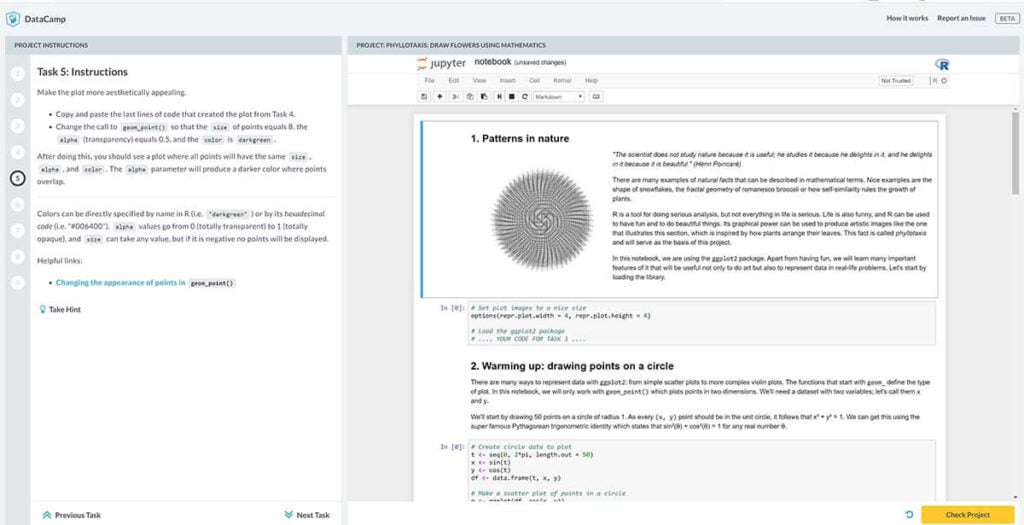
R tracks
DataCamp offers 6 R-based Career Track options:
- R Programmer (43 hours, 9 courses)
- Data Scientist with R (89 hours, 22 courses)
- Data Analyst with R (64 hours, 19 courses)
- Quantitative Analyst with R (65 hours, 15 courses)
- Statistician with R (56 hours, 14 courses)
- Machine Learning Specialist with R (61 hours, 15 courses)
DataCamp also offers numerous R Skill Tracks that are shortened versions of the beforementioned Career Tracks.
DataCamp certificates
DataCamp offers certificates, referred to as statements of accomplishment, for all of their courses and tracks. These can be added to your resume or LinkedIn page, to showcase your newfound knowledge and skills to potential employers. While the intrinsic value of these certificates is not particularly high, the knowledge and skills gained in the process of earning the certificate certainly are.
Many serious data scientists already have dozens, if not close to a hundred, DataCamp courses completed, so a single course certificate will likely not be enough to land you a job in the industry.
Can DataCamp certificates get you a job?
Indirectly – yes. To get a data science job through DataCamp, you should use your learned skills to perform real data analysis. Find a company you’d like to work for and an industry-relevant database. Then, make short data analysis of their industry and write an industry-specific report.
Instead of simply plotting a DataCamp certificate on your resume, this strategy will likely be more effective. Employers want to see how your mind works and how you do data analysis. They don’t want to read the certificates of candidates.
How to get a DataCamp certificate?
To get a DataCamp certificate, you must first choose a course and pass all the course lessons. After you have done so, the course will show up under the “completed” tab of your dashboard, and from there you can download certificates for any courses you have completed.
Are DataCamp certificates worth it?
Paying for DataCamp only for obtaining certificates is not worth it, because employers don’t hire candidates solely for a MOOC certificate. However, DataCamp itself is worth it, because it teaches numerous highly useful skillsets for data scientists. The skills and knowledge are worth much more than a certificate.
Sharing DataCamp certificates on CVs & LinkedIn
Simply placing a DataCamp course title on your resume or LinkedIn page will do you little good, as many data scientists and employers still have no idea of what’s DataCamp. Instead, describe what you did during the course. Detail the tools, methods, techniques, and datasets that you used to get results.
Jason T Widjaja, a Data science team lead and hiring manager, gave some excellent tips for this on Quora. He detailed his thought process behind using DataCamp courses for landing a job. His advice: instead of relying on grades or certificates, try to analyze a company-specific data set and write a small report on it. This would demonstrate your familiarity with both data science and the industry of the company much better than a boring certificate.
Now, it’s time to start summing up my evaluation of DataCamp.
Review of DataCamp's SQL courses
When it comes to databases and programming, the first language that usually comes to people’s minds is SQL. After all, it’s a programming language designed for a very specific purpose. That purpose is querying data from databases that use SQL, such as MySQL or MariaDB. SQL and other data science programming languages work together harmoniously. While SQL is used for querying databases, languages like R and Python are used for analyzing that same data.
With SQL, data scientists can:
- Query data from regional databases
- Create, clean and filter datasets
- Update data inside databases
SQL has been an inseparable part of data science since its inception in 1974. Any budding data scientist who wants to be taken seriously should at least be familiar with the basics of SQL programming.
Is DataCamp good for learning SQL?
Yes, DataCamp is a great website for learning SQL. While the selection of SQL courses on DataCamp is not as strong as for courses in R or Python, it’s still one of the best-in-class websites for learning data science with SQL.
SQL courses
The selection of SQL courses on DataCamp is relatively limited at a total of 24 courses. However, all of the basic and intermediate topics in SQL programming are covered throughout the various courses. Therefore, DataCamp still serves as an excellent resource for learning data science and analytics with SQL.
With SQL, there are not as many advanced topics to cover as with Python or R, so it makes sense that DataCamp would focus its efforts more on the latter two languages. SQL is worth picking up, but you might be better off dedicating more time and resources to R and Python, as the majority of daily work tends to take place through those two languages.
Here are some of DataCamp’s most noteworthy SQL courses:
- “Introduction to SQL” by Nick Carchedi serves as an excellent introduction to programming with SQL. It covers many of the fundamental topics in SQL such as column selection, row filtering, aggregate functions, and result sorting & grouping. If you’re completely new to SQL, then this course is the best place to start with.
- “SQL for Joining Data” by Chester Ismay is another beginner-oriented SQL course on DataCamp. It teaches various topics such as nested queries, set theory with Venn diagrams, outer joins, and cross joins. When combined with the introduction course to SQL, you will already have a solid grasp of the SQL language.
SQL projects
As of the writing of this DataCamp review, there are only two available projects based around the SQL programming language. These two projects are:
- “Introduction to DataCamp Projects” by David Venturi. This SQL project is designed to serve as an introduction to DataCamp projects. It makes use of Jupyter notebooks and it’s a good introductory project for anyone curious about how DataCamp projects work.
- “Analyze International Debt Statistics” by Sayak Paul. This project is more advanced than the previous, and its purpose is to analyze data sets gathered from The World Bank to perform data analysis of the debts of various world governments.
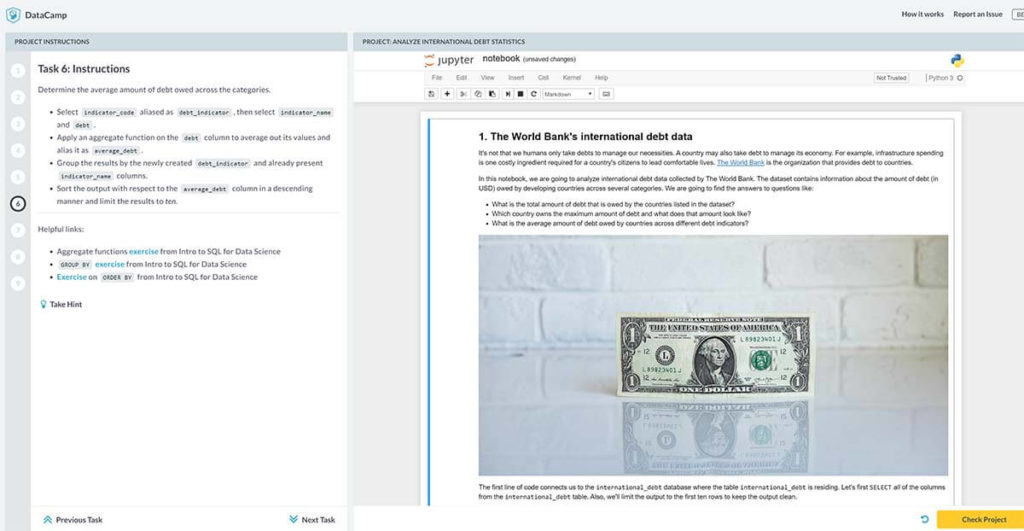
SQL tracks
While the choice for R and Python Tracks is far superior, DataCamp does also offer a single full SQL Career Track:
- Data Analyst with SQL: 45 hours, 11 courses
And, DataCamp also offers 6 SQL-based Skill Tracks:
- SQL Fundamentals: 11 hours, 5 courses
- SQL Server Fundamentals: 22 hours, 5 courses
- SQL for Business Analysts: 20 hours, 5 courses
- SQL Server for Database Administrators: 28 hours, 7 courses
- SQL for Database Administrators: 16 hours, 4 courses
What is DataCamp Workspace?
One of DataCamp’s more exciting new features that have been added since my last update is DataCamp Workspace. It’s an integrated development environment (IDE) purpose-built by DataCamp for learning data science with Python and R, and it’s a unique tool for the task.
Among other things, DataCamp Workspace allows you to:
- Preload datasets, recipes, and playbooks for you to analyze. Here’s a full list of them.
- Publish a portfolio of work within your profile so that you can showcase your hands-on projects to potential employers.
These two features alone make DataCamp Workspace a great tool for learning data science in an interactive, hands-on way. Plus, for job seekers, having the chance to create a public portfolio without the typical learning curve is a godsend. It’s even available for free within the Basic plan, but keep in mind that the speed and memory allocated to you will be relatively meager.
What I liked: DataCamp pros
I would consider DataCamp to be one of the best learning platforms for studying data science. There are numerous reasons why I feel confident in saying that.
These are the pros of using DataCamp:
- A large variety of courses to choose from
- Covers all major data science languages: R, Python, and SQL
- Lots of practical projects to choose from
- Lots of expert instructors
- Excellent web-based code editor
- Content is very beginner-friendly
- Course lessons can be taken offline
- DataCamp app for mobile learning
What I didn’t like: DataCamp cons
While there are many benefits to using DataCamp, the platform is not exactly without faults either. There are some negative aspects of the learning platform which I believe take away from the overall learning experience.
These are the cons of using DataCamp:
- Poor selection of courses for free users
- Experts might find the content unchallenging
- Too much of the code comes pre-written
Review conclusion: is DataCamp worth it in 2022?
Yes, DataCamp was worth it when we first reviewed it three years ago, and it is even more worth it now. The platform has only gotten bigger and better, with more courses, more languages, more projects, and more expert instructors. Plus, with the addition of new features such as the DataCamp Workspace, the value of a subscription only continues to climb.
One look at the pros and cons sections of this DataCamp review should reveal that I had a very positive overall experience with the platform. There are some small things here and there that could be improved upon. The overall learning experience on DataCamp, however, was a fantastic experience. I thoroughly enjoyed working with the web-based code editor (although it often wrote 90% of the code for me), and I loved the overall user-friendliness of the website. Therefore, I strongly recommend using DataCamp for learning data science and analytics with R, Python, and SQL.
50% off Unlimited Data and AI Learning (expires 28 March 2024)
